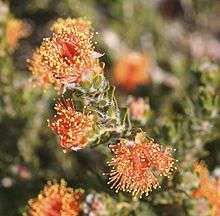Eremaea beaufortioides
| Eremaea beaufortioides | |
|---|---|
 | |
| Scientific classification | |
| Kingdom: | Plantae |
| Clade: | Angiosperms |
| Clade: | Eudicots |
| Clade: | Rosids |
| Order: | Myrtales |
| Family: | Myrtaceae |
| Genus: | Eremaea |
| Species: | E. beaufortioides |
| Binomial name | |
| Eremaea beaufortioides | |
| Synonyms | |
Eremaea beaufortioides is a plant in the myrtle family, Myrtaceae and is endemic to the south-west of Western Australia. It is a spreading shrub with oval to egg-shaped leaves, and orange flowers in spring. Flowers appear in groups of one to six on the ends of long branches formed in the previous year. It is commonly cultivated and is the most familiar of the eremaeas.[1]
Description
Eremaea beaufortioides is a spreading shrub growing to a height of 2.2 metres (7 ft). Its leaves are 2.9–5.6 millimetres (0.1–0.2 in) long, 1.4–4.2 millimetres (0.06–0.2 in) wide, flat, linear to broad egg-shaped and with up to 7 veins sometimes visible on the lower surface. There is variation in leaf size and shape between the three varieties of the species.[2][3]
The flowers are orange-coloured and arranged in groups of up to six on the ends of the branches of the previous year's growth. There are 5 sepals and 5 petals 3.5–5.7 millimetres (0.1–0.2 in) long. The stamens, which give the flower its colour, are arranged in 5 bundles, each containing 34 to 48 stamens. Flowering occurs from September to December and is followed by fruits which are woody capsules. The capsules are more or less barrel-shaped, smooth and 8–11 millimetres (0.3–0.4 in) long and 2.8–6.1 millimetres (0.1–0.2 in) wide.[2]
Taxonomy and naming
Eremaea beaufortioides was first formally described in 1867 by George Bentham in Flora Australiensis.[4][5] The specific epithet (beaufortioides) is presumably a reference to the similarity of this species to a species of Beaufortia since εἶδος (eîdos) is an Ancient Greek word meaning “form" or "likeness”.[2][6]
There are three varieties:[2]
- Eremaea beaufortioides var. beaufortioides has thin leaves with 5 or more veins and flowers with a glabrous hypanthium;[7]
- Eremaea beaufortioides var. lachnostanthe has thin leaves with 3 veins and flowers with a densely hairy hypanthium;[8]
- Eremaea beaufortioides var. microphylla has small, thick leaves with fewer than 3 veins which may be hard to see.[9]
Distribution and habitat
Eremaea beaufortioides is found in the Irwin district[2] in the Avon Wheatbelt, Geraldton Sandplains, Swan Coastal Plain and Yalgoo biogeographic regions.[3] It grows in sand over laterite.[10]
Conservation
Eremaea beaufortioides is classified as "not threatened" by the Western Australian Government Department of Parks and Wildlife.[3]
Use in horticulture
Eremaea beaufortioides is an attractive species but although it is the hardiest of its genus, is difficult to grow in more humid areas unless grafted. It needs a sunny position and excellent drainage.[1][11]
References
- 1 2 "Eremaea beaufortioides". Australian Native PlantsSociety Australia. Retrieved 10 August 2015.
- 1 2 3 4 5 Hnatiuk, Roger J. (1998). "A revision of the genus Eremaea (Myrtaceae)" (PDF). Nuytsia. 9 (2): 167–169. Retrieved 9 August 2015.
- 1 2 3 "Eremaea atala". FloraBase. Retrieved 9 August 2015.
- ↑ "Eremaea beaufortioides". APNI. Retrieved 10 August 2015.
- ↑ Bentham, George (1867). Flora Australiensis (Volume 3). London: Lovell Reeve and Co. p. 182. Retrieved 10 August 2015.
- ↑ Brown, Roland Wilbur (1956). The Composition of Scientific Words. Washington, D.C.: Smithsonian Institution Press. p. 483.
- ↑ "Eremaea beaufortioides var. beaufortioides". FloraBase. Retrieved 10 August 2015.
- ↑ "Eremaea beaufortioides var. lachnostanthe". FloraBase. Retrieved 10 August 2015.
- ↑ "Eremaea beaufortioides var. microphylla". FloraBase. Retrieved 10 August 2015.
- ↑ Paczkowska, Grazyna; Chapman, Alex R. (2000). The Western Australian flora : a descriptive catalogue. Perth: Wildflower Society of Western Australia. p. 362. ISBN 0646402439.
- ↑ Wrigley, John W.; Fagg, Murray (1983). Australian native plants : a manual for their propagation, cultivation and use in landscaping (2nd ed.). Sydney: Collins. p. 212. ISBN 0002165759.